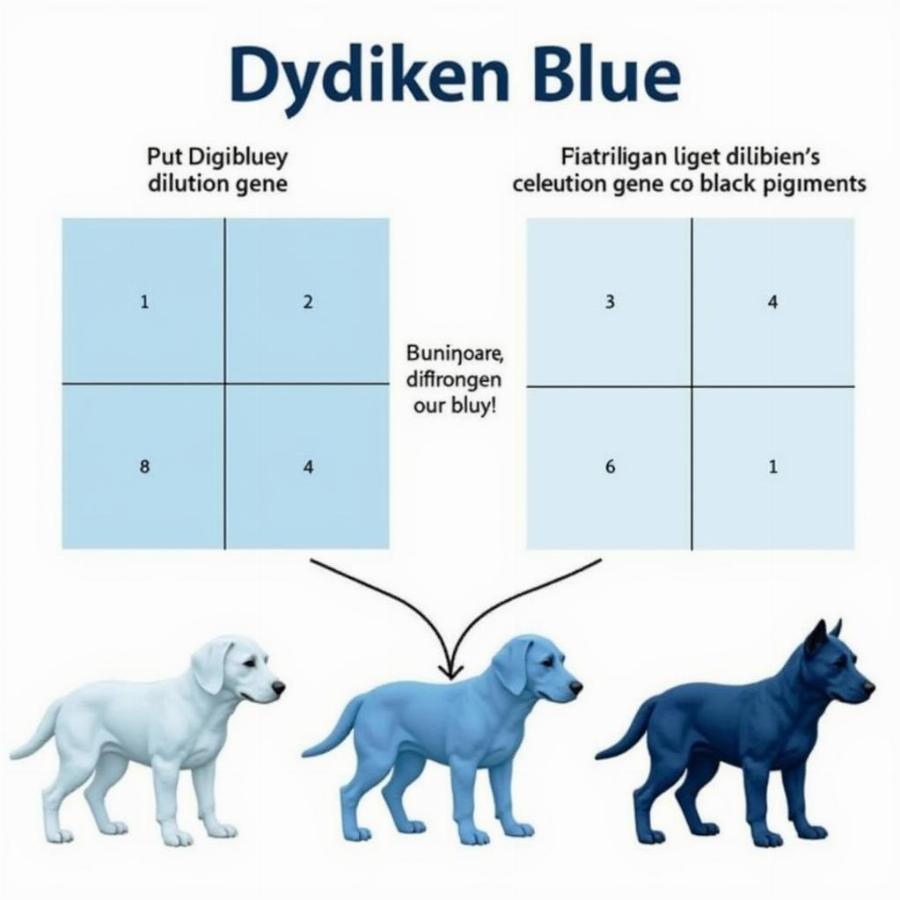Bluey dog colors are a fascinating and often misunderstood aspect of canine genetics. This unique coat color, often a dilute of black, captivates dog lovers with its subtle beauty and range of shades. Whether you’re curious about the science behind bluey coats, or considering a blue-coated breed, this guide will explore everything you need to know about this striking canine characteristic.
Decoding the Genetics of Bluey Dog Colors
 Hình ảnh minh họa về di truyền học màu lông xanh ở chó
Hình ảnh minh họa về di truyền học màu lông xanh ở chó
The “blue” in a dog’s coat isn’t actually blue. It’s a diluted form of black pigment, created by the dilution gene. This gene modifies the intensity of black pigment, resulting in a range of greyish-blue hues. The specific shade depends on other genetic factors and can vary from a light, almost silvery blue to a deep slate or charcoal color. This dilution gene is recessive, meaning a dog needs two copies of the gene to express the blue coat color.
Understanding the Dilution Gene
The dilution gene responsible for bluey coats is known as the MLPH (Melanophilin) gene. This gene affects the distribution of melanin granules, which determine pigment intensity. In blue dogs, these granules clump together, resulting in a diluted appearance. This is the same gene that causes dilution in other animal species, resulting in similar muted color variations.
Bluey Dog Breeds: A Spectrum of Shades
Many breeds are known for their beautiful bluey coats. Some popular examples include the Weimaraner, known for its distinctive silvery-grey coat, the Kerry Blue Terrier with its deep slate color, and the Australian Cattle Dog (Blue Heeler), featuring a mottled blue and tan coat. Other breeds that can display bluey coats include the Shar-Pei, Great Dane, and Whippet.
Choosing a Bluey Breed
If you’re captivated by bluey dog colors, choosing the right breed is crucial. Consider factors like temperament, energy levels, and grooming needs. Do your research and ensure the breed aligns with your lifestyle and experience with dogs. dog toy blue
Caring for a Bluey Coat: Tips and Tricks
While genetically diluted, blue coats require the same basic care as any other coat color. Regular brushing helps prevent matting and distributes natural oils. Bathing should be done as needed, using a gentle shampoo formulated for dogs.
Common Coat Concerns
Some blue-coated breeds can be prone to certain skin conditions, such as Color Dilution Alopecia (CDA). CDA can cause hair loss and skin inflammation. While not all blue dogs will develop CDA, it’s important to be aware of the potential risk and monitor your dog’s skin for any changes.
Is My Dog Truly Blue? Distinguishing Blue from Other Colors
Sometimes, what appears as blue may actually be another color. For instance, a very dark grey can sometimes look blue in certain lighting. Similarly, a liver-colored coat, a diluted form of brown, can sometimes appear bluish-grey. Understanding the genetics and breed standards can help you distinguish true blue from similar shades.
Conclusion: Embracing the Elegance of Bluey Dog Colors
Bluey dog colors offer a unique and captivating aesthetic. From the silvery shimmer of a Weimaraner to the deep slate of a Kerry Blue Terrier, these diluted shades add an element of elegance and intrigue to the canine world. By understanding the genetics and care requirements of these beautiful coats, you can appreciate the unique beauty of bluey dogs.
FAQ: Your Burning Questions about Bluey Dog Colors Answered
- Are blue dogs more prone to health problems? Some blue-coated breeds can be predisposed to certain skin conditions, but blue itself doesn’t cause health issues.
- Do blue dogs shed? Yes, all dogs shed, regardless of coat color.
- Can two non-blue dogs produce blue puppies? Yes, if both parents carry the recessive dilution gene.
- Are blue dogs rarer than other colors? It depends on the breed. In some breeds, blue is a standard color, while in others it’s less common.
- How can I tell if my dog is truly blue? Genetic testing can confirm the presence of the dilution gene.
Explore More about Dog Coats and Colors
Looking for more information on dog coats and colors? Check out our article on dog coat genetics.
Beaut Dogs is your trusted source for all things canine, offering expert advice and resources to help you provide the best care for your furry friend. From breed information to health tips, Beaut Dogs is here to support you every step of the way. When you need assistance, please contact us at [email protected] (Email address) for detailed and accurate answers.